Formation Mechanism of Residual Stresses in Micro-Injection Molding of PMMA: A Molecular Dynamics Simulation
Abstract
1. Introduction
2. Materials and Methods
2.1. Model Constructing
2.2. Force Field
2.3. Simulation Procedure
3. Results and Discussion
3.1. Dynamic Stresses during Injection Molding
3.2. Evolution of Molecular Morphology and Structure
3.3. Effect of the Aspect Ratio of the Nano-Cavity
4. Conclusions
Author Contributions
Funding
Conflicts of Interest
Nomenclature
| Stiffness constant of bond stretching potential | |
| Stiffness constant of angular bending potential | |
| Stiffness constant of torsion potential | |
| , | Bond length and equilibrium bond length |
| , | Bond angle and equilibrium bond angle |
| , | Torsion angle and equilibrium torsion angle |
| Zero-potential distance of Lennard-Jones | |
| Well depth of Lennard-Jones | |
| Distance between the atom and | |
| , | Maximum and minimum values of the height of bottom after demolding |
| , | Maximum and minimum values of the width of bottom after demolding |
| , | Maximum and minimum values of the height of shoulder after demolding |
| , | Values of the height and width of bottom before demolding |
| Values of the height of shoulder before demolding |
References
- Wu, J.; He, Z.; Chen, Q.; Lin, J. Biochemical analysis on microfluidic chips. TrAC Trends Anal. Chem. 2016, 80, 213–231. [Google Scholar] [CrossRef]
- Kamaly, N.; Fredman, G.; Fojas, J.J.R.; Subramanian, M.; Choi, W.I.; Zepeda, K.; Vilos, C.; Yu, M.; Gadde, S.; Wu, J.; et al. Targeted interleukin-10 nanotherapeutics developed with a microfluidic chip enhance resolution of inflammation in advanced atherosclerosis. ACS Nano 2016, 10, 5280–5292. [Google Scholar] [CrossRef]
- Weng, C.; Wang, F.; Zhou, M.; Yang, D.; Jiang, B. Fabrication of hierarchical polymer surfaces with superhydrophobicity by injection molding from nature and function-oriented design. Appl. Surf. Sci. 2018, 436, 224–233. [Google Scholar] [CrossRef]
- Gupta, M.C.; Ungaro, C.; Foley, J.J.; Gray, S.K. Optical nanostructures design, fabrication, and applications for solar/thermal energy conversion. Sol. Energy 2018, 165, 100–114. [Google Scholar] [CrossRef]
- Huang, H.X.; Wang, X. Biomimetic fabrication of micro-/nanostructure on polypropylene surfaces with high dynamic superhydrophobic stability. Mater. Today Commun. 2019, 19, 487–494. [Google Scholar] [CrossRef]
- Stormonth-Darling, J.M.; Saeed, A.; Reynolds, P.M.; Gadegaard, N. Injection molding micro- and nanostructures in thermoplastic elastomers. Macromol. Mater. Eng. 2016, 301, 964–971. [Google Scholar] [CrossRef] [PubMed]
- Kim, B.; Min, J. Residual stress distributions and their influence on post-manufacturing deformation of injection-molded plastic parts. J. Mater. Process. Technol. 2017, 245, 215–226. [Google Scholar] [CrossRef]
- Macías, C.; Meza, O.; Pérez, E. Relaxation of residual stresses in plastic cover lenses with applications in the injection molding process. Eng. Fail. Anal. 2015, 57, 490–498. [Google Scholar] [CrossRef]
- Jeong, S.; Kim, J.M.; Baig, C. Effect of chain orientation and stretch on the stress overshoot of entangled polymeric materials under start-up shear. Macromolecules 2017, 50, 3424–3429. [Google Scholar] [CrossRef]
- Jarecki, L.; Misztal-faraj, B. Non-linear stress-orientation behavior of flexible chain polymers under fast elongational flow. Eur. Polym. J. 2017, 95, 368–381. [Google Scholar] [CrossRef]
- Salmoria, G.V.; Vieira, L.F.; Gindri, I.M.; Roesler, C.R.M.; Fancello, E.A. Properties of injection-molded poly (l-co-d,l-lactic acid) using different melt temperatures and stress concentrator in the specimen geometry. Int. J. Adv. Manuf. Technol. 2018, 98, 2231–2237. [Google Scholar] [CrossRef]
- Yue, P. Molecular orientation distribution in PC products analyzed by birefringence. Phys. B Phys. Condens. Matter 2019, 563, 56–61. [Google Scholar] [CrossRef]
- Weng, C.; Lee, W.B.; To, S. Birefringence techniques for the characterization of residual stresses in injection-moulded micro-lens arrays. Polym. Test. 2009, 28, 709–714. [Google Scholar] [CrossRef]
- Ghiam, F.; White, J.L. Phase morphology of injection-molded blends of nylon-6 and polyethylene and comparison with compression molding. Polym. Eng. Sci. 1991, 31, 76–83. [Google Scholar] [CrossRef]
- Lin, C.-M.; Hsieh, H.-K. Processing optimization of Fresnel lenses manufacturing in the injection molding considering birefringence effect. Microsyst. Technol. 2017, 23, 5689–5695. [Google Scholar] [CrossRef]
- Liparoti, S.; Sorrentino, A.; Titomanlio, G. Rapid control of mold temperature during injection molding process: Effect of packing pressure. AIP Conf. Proc. 2015, 1695, 10–14. [Google Scholar]
- Kim, C.H.; Youn, J.R. Determination of residual stresses in injection-moulded flat plate: Simulation and experiments. Polym. Test. 2007, 26, 862–868. [Google Scholar] [CrossRef]
- Polymeris, G.S.; Vlachos, N.; Khan, A.U.; Hatzikraniotis, E.; Lioutas, C.B.; Delimitis, A.; Pavlidou, E.; Paraskevopoulos, K.; Kyratsi, T.; Kyratsi, T. Nanostructure and doping stimulated phase separation in high-ZT Mg2Si0.55Sn0.4Ge0.05 compounds. Acta Mater. 2015, 83, 285–293. [Google Scholar] [CrossRef]
- Wang, S.; Javadpour, F.; Feng, Q. Molecular dynamics simulations of oil transport through inorganic nanopores in shale. Fuel 2016, 171, 74–86. [Google Scholar] [CrossRef]
- Zhou, M.; Jiang, B.; Weng, C. Molecular dynamics study on polymer filling into nano-cavity by injection molding. Comput. Mater. Sci. 2016, 120, 36–42. [Google Scholar] [CrossRef]
- Yeh, I.-C.; Andzelm, J.W.; Rutledge, G.C. Mechanical and structural characterization of semicrystalline polyethylene under tensile deformation by molecular dynamics simulations. Macromolecules 2015, 48, 4228–4239. [Google Scholar] [CrossRef]
- Wang, B.-B.; Xu, Z.-M.; Wang, X.-D.; Yan, W.-M. Molecular dynamics investigation on enhancement of heat transfer between electrified solid surface and liquid water. Int. J. Heat Mass Transf. 2018, 125, 756–760. [Google Scholar] [CrossRef]
- Thomas, T.M.; Vinod, N. Convective heat transfer between liquid argon flows and heated carbon nanotube arrays using molecular dynamics. J. Appl. Fluid Mech. 2019, 12, 971–980. [Google Scholar] [CrossRef]
- Zhang, J.; Hong, Y.; Liu, M.; Yue, Y.; Xiong, Q.; Lorenzini, G. Molecular dynamics simulation of the interfacial thermal resistance between phosphorene and silicon substrate. Int. J. Heat Mass Transf. 2017, 104, 871–877. [Google Scholar] [CrossRef]
- Xu, G.; Wang, H. Molecular dynamics study of interfacial mechanical behavior between asphalt binder and mineral aggregate. Constr. Build. Mater. 2016, 121, 246–254. [Google Scholar] [CrossRef]
- Xu, G.; Wang, H. Study of cohesion and adhesion properties of asphalt concrete with molecular dynamics simulation. Comput. Mater. Sci. 2016, 112, 161–169. [Google Scholar] [CrossRef]
- Min, K.; Kim, Y.; Goyal, S.; Lee, S.H.; McKenzie, M.; Park, H.; Savoy, E.S.; Rammohan, A.R.; Mauro, J.C.; Kim, H.; et al. Interfacial adhesion behavior of polyimides on silica glass: A molecular dynamics study. Polym. 2016, 98, 1–10. [Google Scholar] [CrossRef]
- Yang, S.; Yu, S.; Cho, M. Influence of mold and substrate material combinations on nanoimprint lithography process: MD simulation approach. Appl. Surf. Sci. 2014, 301, 189–198. [Google Scholar] [CrossRef]
- Kang, J.-H.; Kim, K.-S.; Kim, K.-W. Molecular dynamics study of pattern transfer in nanoimprint lithography. Tribol. Lett. 2007, 25, 93–102. [Google Scholar] [CrossRef]
- Kang, J.-H.; Kim, K.-S.; Kim, K.-W. Molecular dynamics study on the effects of stamp shape, adhesive energy, and temperature on the nanoimprint lithography process. Appl. Surf. Sci. 2010, 257, 1562–1572. [Google Scholar] [CrossRef]
- Fang, T.; Wu, C.; Chang, W.; Chi, S. Effect of thermal annealing on nanoimprinted Cu—Ni alloys using molecular dynamics simulation. Appl. Surf. Sci. 2009, 255, 6043–6047. [Google Scholar] [CrossRef]

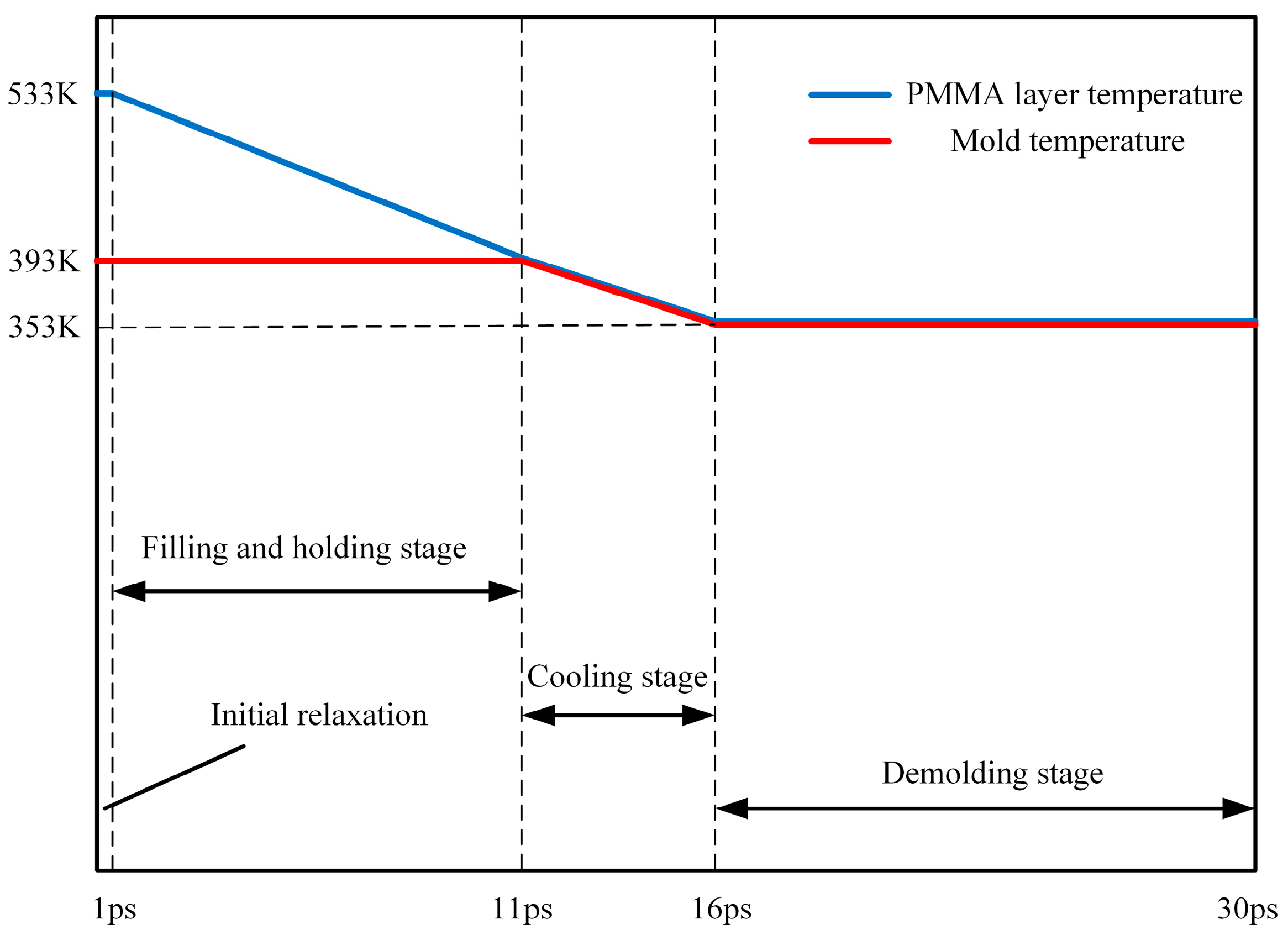

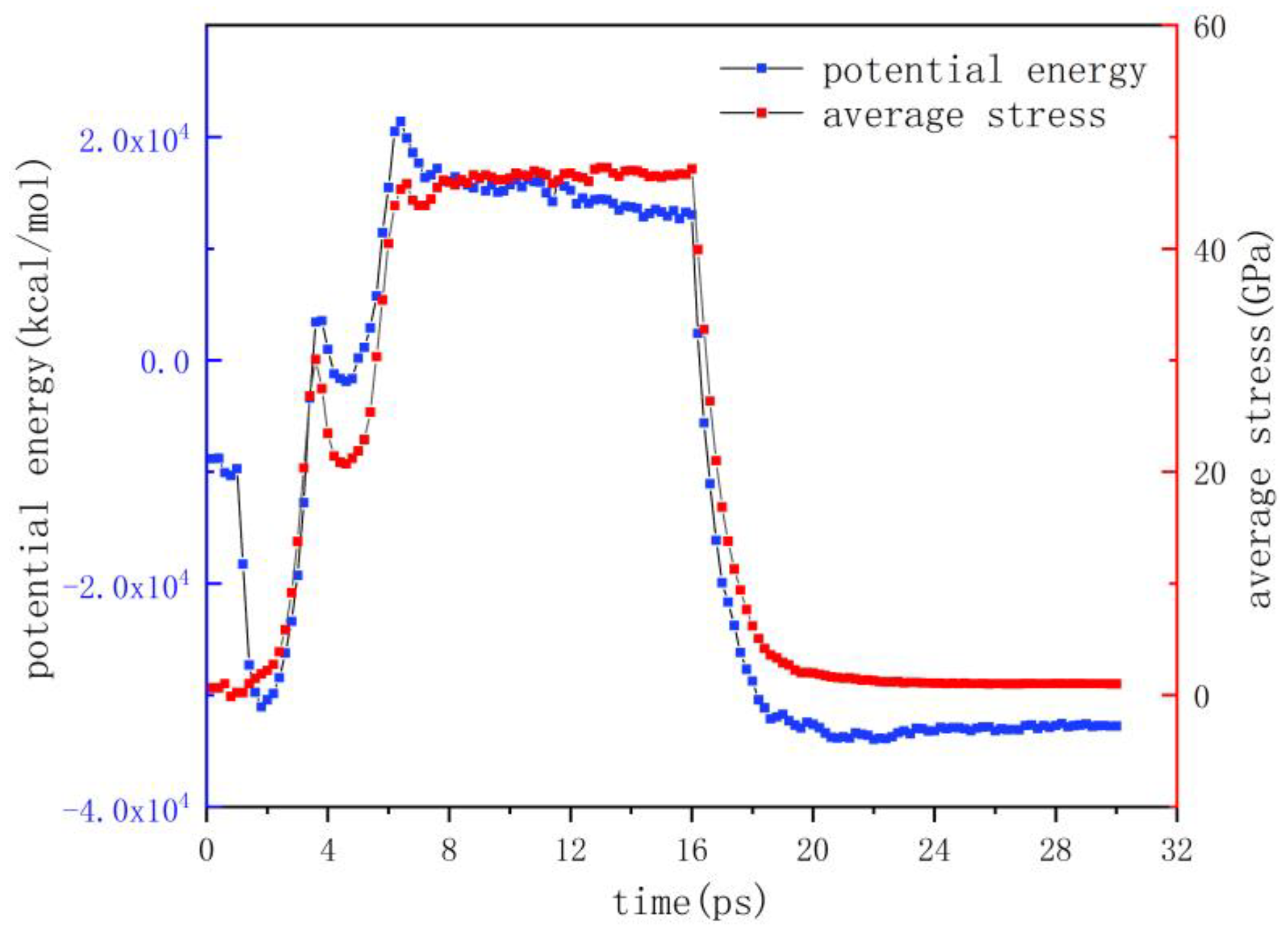
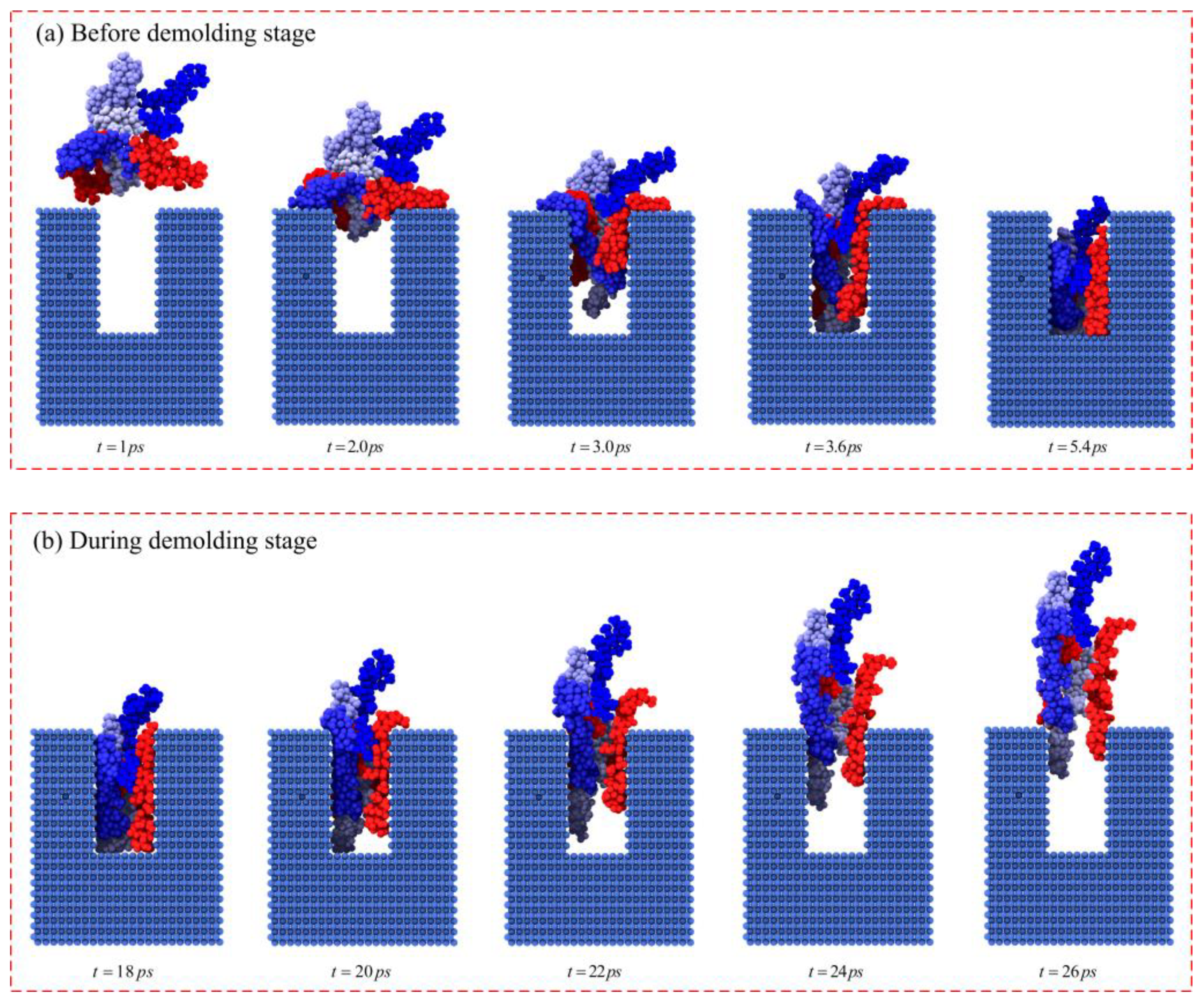
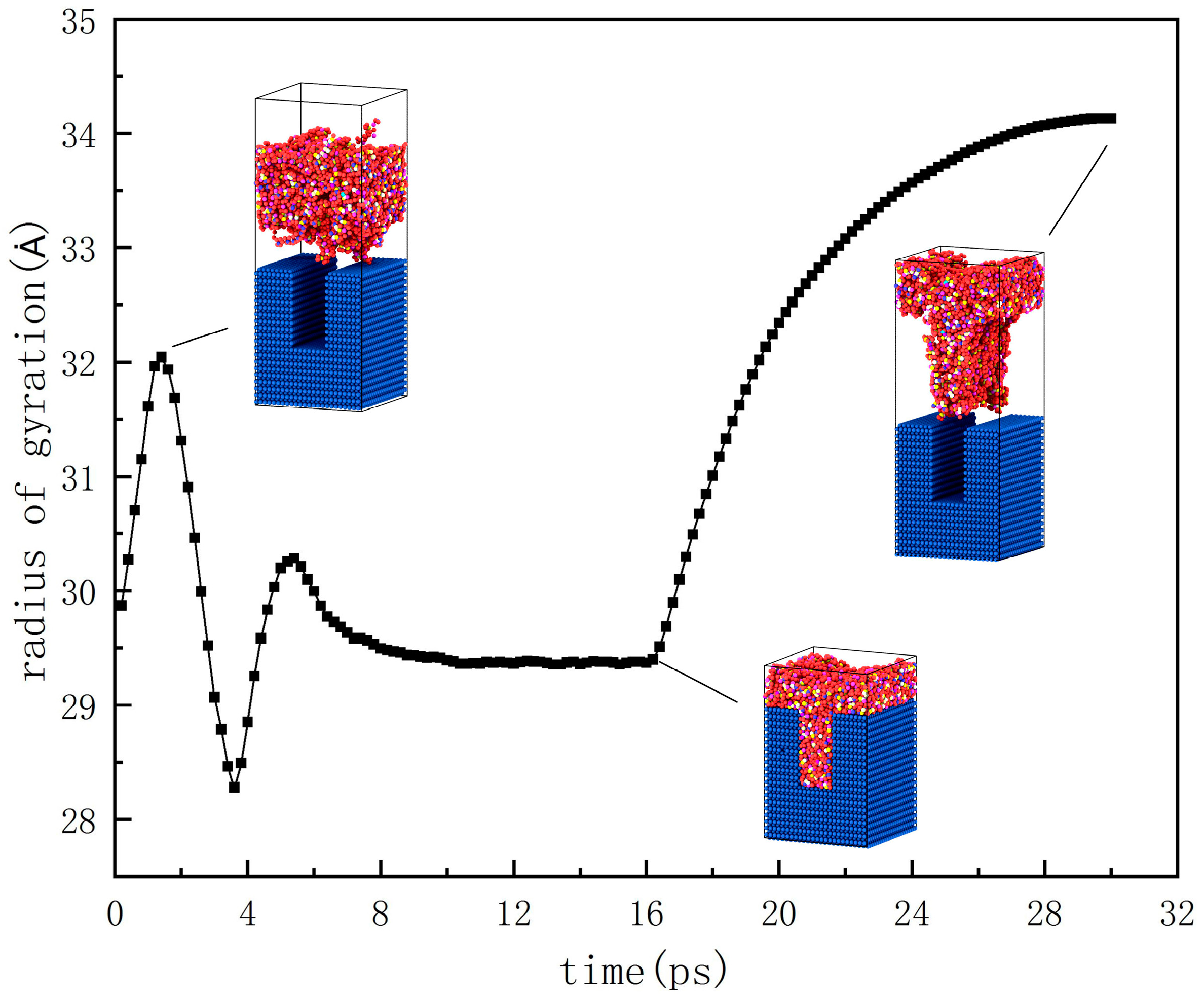
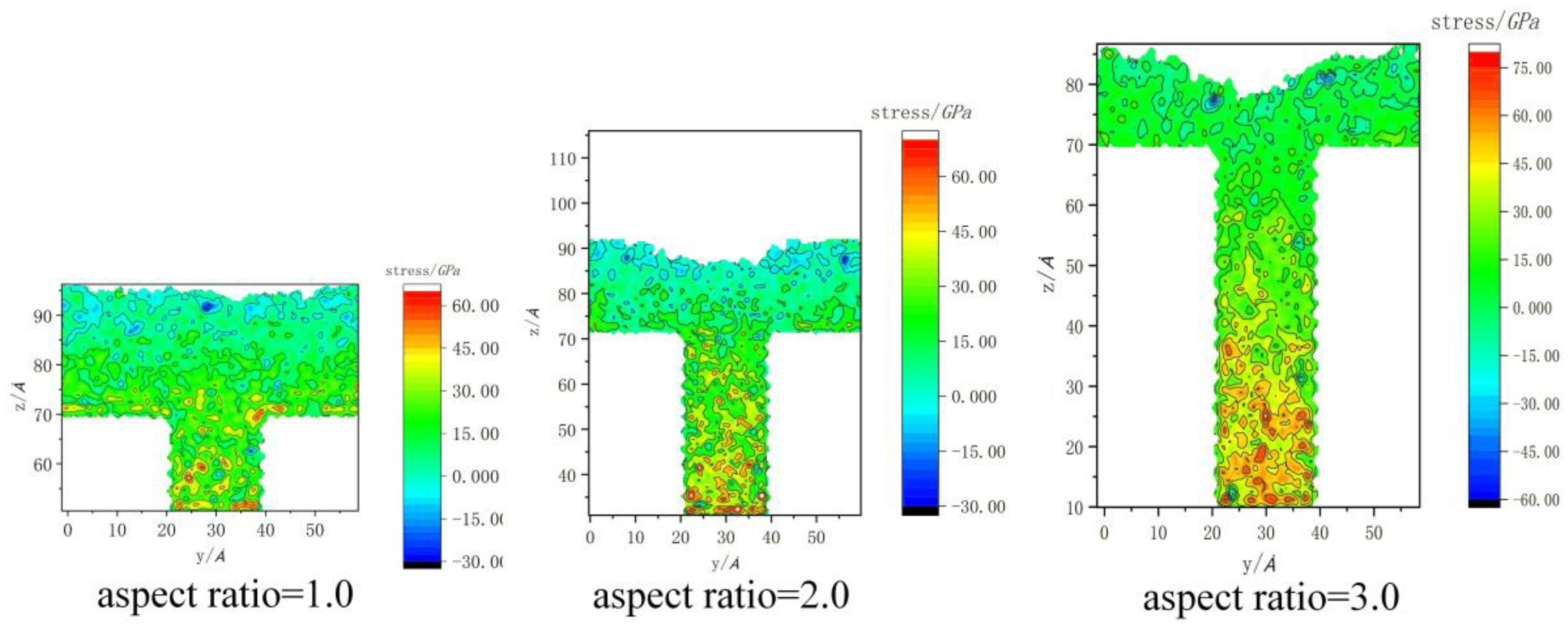


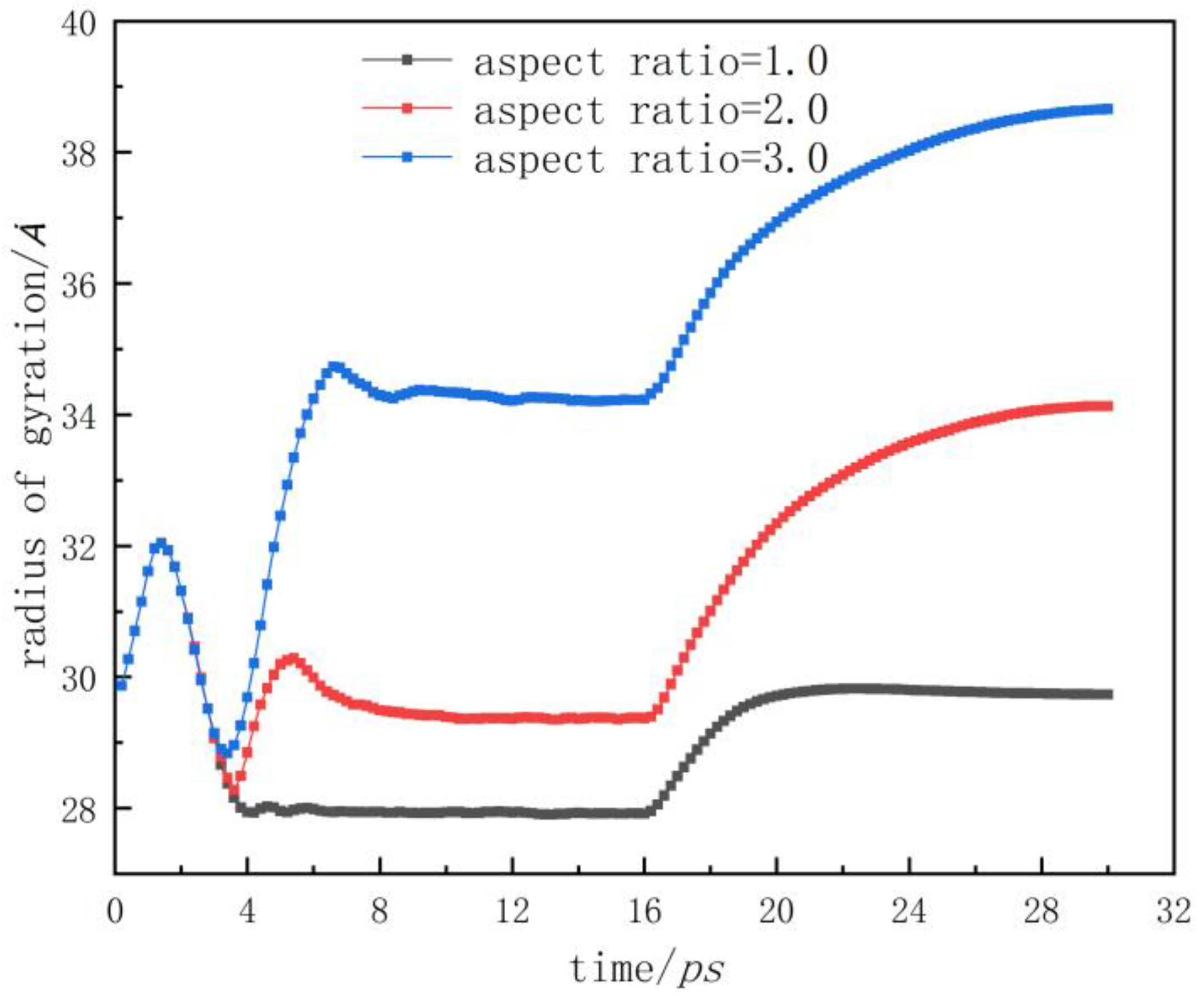
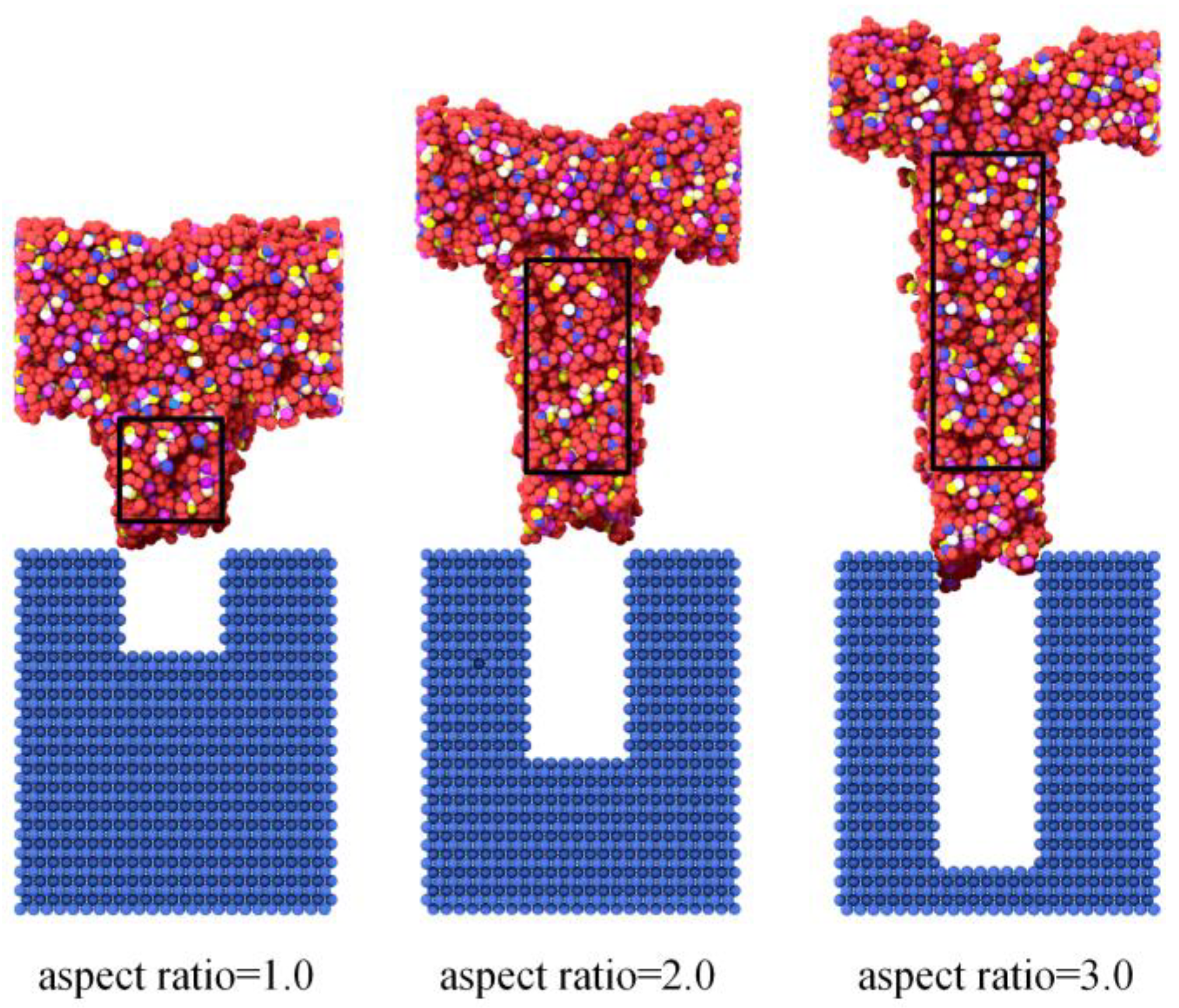

© 2020 by the authors. Licensee MDPI, Basel, Switzerland. This article is an open access article distributed under the terms and conditions of the Creative Commons Attribution (CC BY) license (http://creativecommons.org/licenses/by/4.0/).
Share and Cite
Weng, C.; Ding, T.; Zhou, M.; Liu, J.; Wang, H. Formation Mechanism of Residual Stresses in Micro-Injection Molding of PMMA: A Molecular Dynamics Simulation. Polymers 2020, 12, 1368. https://doi.org/10.3390/polym12061368
Weng C, Ding T, Zhou M, Liu J, Wang H. Formation Mechanism of Residual Stresses in Micro-Injection Molding of PMMA: A Molecular Dynamics Simulation. Polymers. 2020; 12(6):1368. https://doi.org/10.3390/polym12061368
Chicago/Turabian StyleWeng, Can, Tao Ding, Mingyong Zhou, Jiezhen Liu, and Hao Wang. 2020. "Formation Mechanism of Residual Stresses in Micro-Injection Molding of PMMA: A Molecular Dynamics Simulation" Polymers 12, no. 6: 1368. https://doi.org/10.3390/polym12061368
APA StyleWeng, C., Ding, T., Zhou, M., Liu, J., & Wang, H. (2020). Formation Mechanism of Residual Stresses in Micro-Injection Molding of PMMA: A Molecular Dynamics Simulation. Polymers, 12(6), 1368. https://doi.org/10.3390/polym12061368







